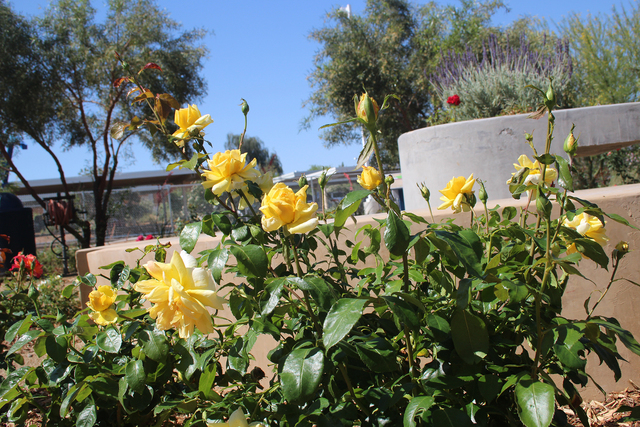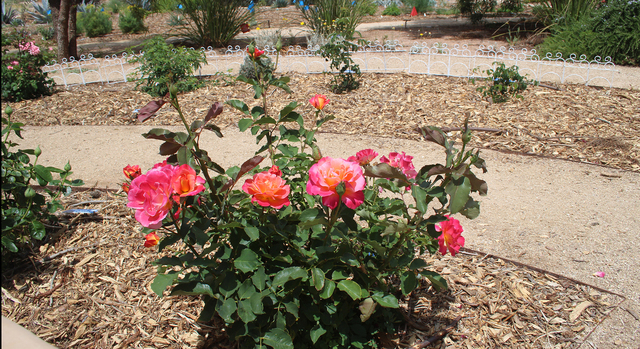Desert dwellers do not have to give up on roses
No matter what temperatures, precipitation and sunshine occur in a climate, people want roses to bloom in their yards.
There are about 100 species, and thousands of cultivars, of this flower, and even in the parched Mojave Desert, they can be desirable additions to the garden. Roses do surprisingly well in this arid climate, which has given me a whole new respect for them.
Until I saw how tough they can be, I thought roses were the spoiled brats of the horticultural universe. But I was wrong. Surely some have been overbred and possibly overfed, but they are so beautiful and durable; how could I help but love them?
According to the staff at Rose Magazine, some members of the genus Rosa actually developed in America, although probably not in Southern Nevada. Most of the ornamental roses we cherish originated in Europe and Asia. Despite the climatic differences, there are many varieties that will grow just fine in this desert.
At the Cooperative Extension office, we have lists of roses that can survive even our challenging conditions. These include a range of growing and flowering types. Not just sturdy shrub roses, but climbers, hybrid teas, miniatures and grandifloras.
Questions about roses and their problems come in regularly to the Master Gardener desk. At Cooperative Extension, we are fortunate to have resources, including expert rosarians, to answer.
In speaking with local rosarians, I learned several things about these amazing plants.
When temperatures get high, as in the summer heat of the Mojave, roses tend not to grow to full size. That makes sense, because, except in true desert plants, several plant enzymes simply shut down when days are hot.
No plant can be expected to spend much of its resources building a flower when its main goal is simply surviving the summer.
Even when it is hot, it’s wise to provide the plant with a little dilute fertilizer. Experts advise giving rosebushes Epsom salts. During the summer, about a tablespoon is sufficient; more is needed during their active growth.
If the leaves look pale, but still have green veins, the plant might be lacking iron, manganese or zinc. You can get these amendments at any local nursery.
Probably, you should also pay attention to making the soil more acidic. Desert soils tend to be alkaline, a frequent cause of those mineral deficiencies. Soil sulfur (not gypsum) increases the acidity of the soil, albeit slowly.
This is not news to anyone: Plants need water. Like many landscape plants, roses do best with deep watering. This means applying more water, less frequently. Most of the time, think about watering once a week.
If temperatures are very high, then maybe you will want to increase the frequency. The water from lawn sprinklers is rarely sufficient to keep a rose happy and healthy. If you plan to be watering deeply, you need to make sure that the soil has good drainage. This goes for roses and virtually all landscape plants. Nothing is worse for roots than excess water at the root zone.
Roses need eight or more hours of direct sun to flower, but late-afternoon desert sun is generally so intense that it can scald the flowers and foliage. It is best to plant them so they receive morning sun.
Other problems afflicting roses are a couple of insect pests, and a disease called powdery mildew. One good way to get rid of small insects such as aphids is to hit them with a strong stream of water from a hose. They rarely fly back onto the plant.
Thrips are more difficult. You musts remove any old material on the ground that might be harboring them. For both these insects, there are biological controls such as lacewings and predatory mites available. Some resources also recommend using neem oil or spinosad.
Powdery mildew looks like powder on the leaves, stems, even on buds and flowers. Some rose varieties are more resistant than others.
It is caused by a fungus that appears anywhere people grow roses, but it appears in this region when the humidity becomes a little high. Limiting this disease can be tricky. Potassium bicarbonate is an effective technique. Researchers are studying biological controls.
Prevention should always be the first defense against any plant problem. Make sure the plants are in places where there is morning sun, and irrigate them in the morning.
If you have a diseased or infested cane or branch, prune it out and destroy it. Always remove old plant debris so it will not be a source for more disease.
Enjoy your beautiful roses. If you want written information on rose care, call the Master Gardener help line, 702-257-5555.
Angela O’Callaghan is the Social Horticulture Specialist for University of Nevada Cooperative Extension. Contact ocallaghana@unce.unr.edu or 702-257-5581.


















